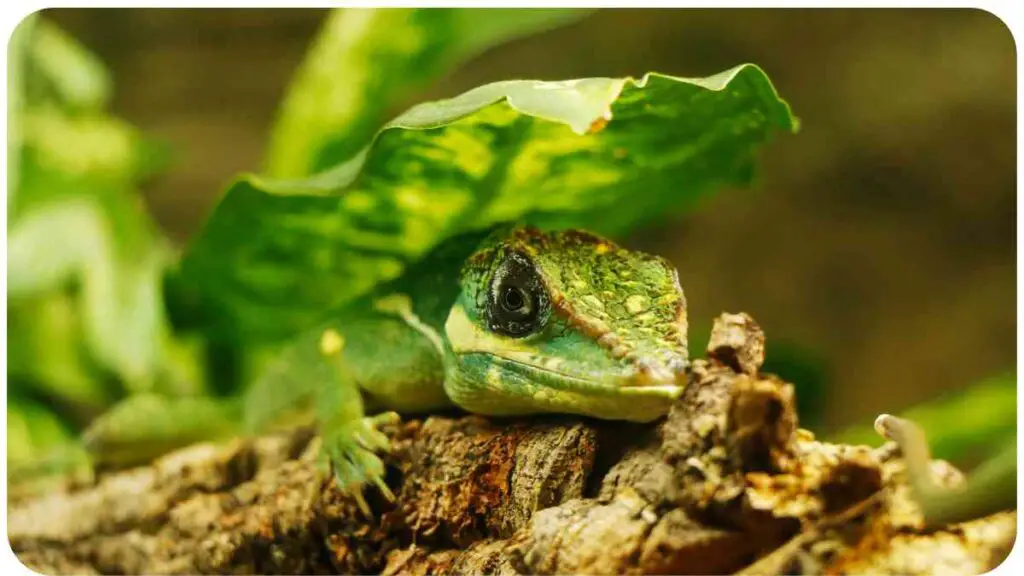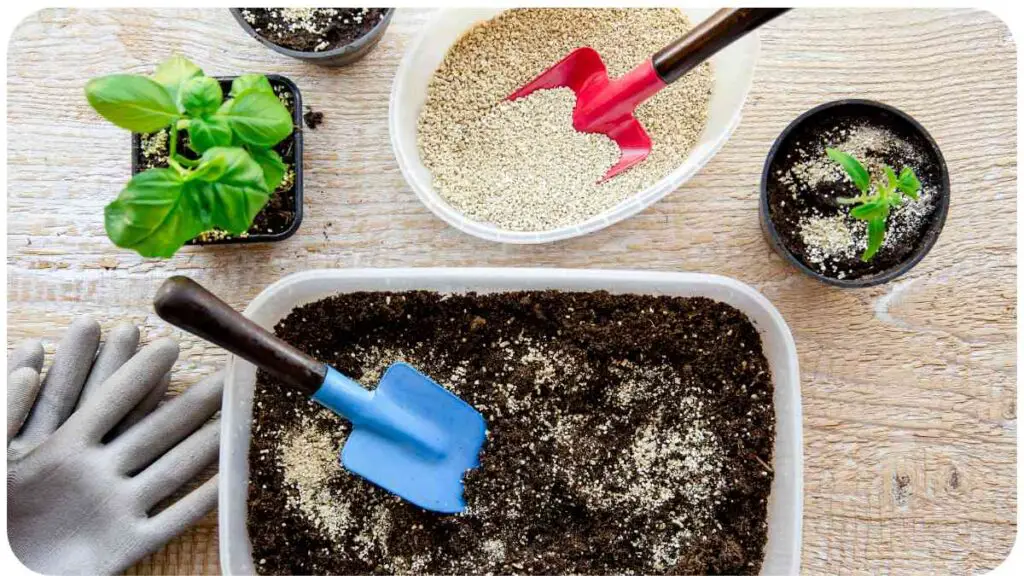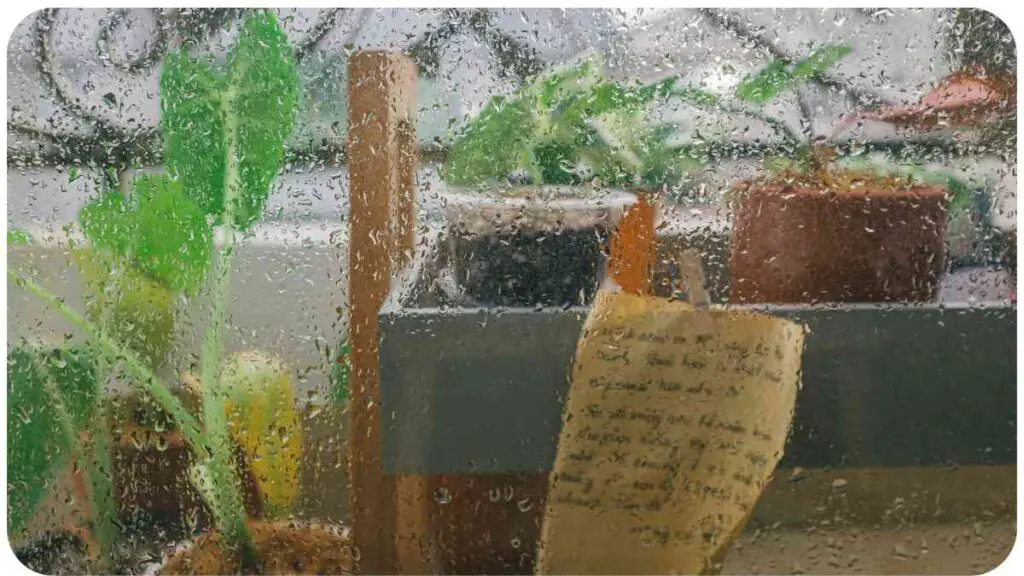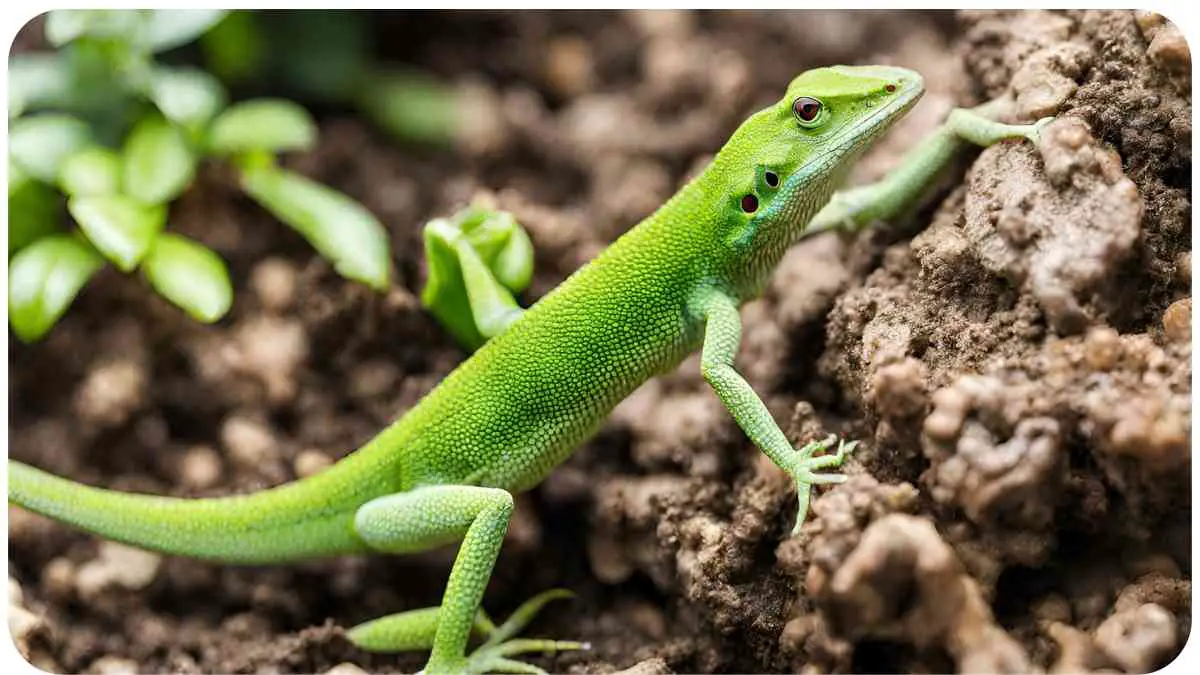Keeping anoles as pets can be a rewarding experience, but it comes with its own set of challenges, particularly when it comes to creating the ideal habitat for them. One common question that many anole owners have is whether potting soil can be used as a substrate for their pets.
In this article, we’ll explore the suitability of potting soil for anoles and provide insights into alternative substrate options.
| Takeaways |
| 1. Potting soil can be a suitable substrate for anoles if chosen carefully and used correctly. |
| 2. Consider alternative substrates such as coconut fiber or reptile carpet, weighing their pros and cons. |
| 3. Prioritize your anole’s health and well-being by maintaining a clean and enriching environment. |
| 4. Monitor humidity levels regularly when using potting soil, as it retains moisture well. |
| 5. Spot clean the enclosure daily and replace soiled substrate as needed to prevent bacterial growth. |
| 6. Provide enrichment activities such as climbing branches and hiding spots to keep anoles mentally stimulated. |
| 7. Choose organic potting soil without added fertilizers or pesticides to minimize potential risks. |
| 8. Watch for signs of illness or distress in your anoles and seek veterinary care promptly if needed. |
| 9. Experiment with substrate mixes to find the best option for your anole’s enclosure, considering their preferences. |
| 10. Regularly research and stay informed about best practices for anole care to ensure the healthiest environment. |
Understanding Anoles

Before delving into the specifics of substrate choices, let’s take a moment to understand these fascinating creatures. Anoles are small lizards belonging to the family Dactyloidae. They are native to the Americas and are known for their ability to change color, which they use for communication and thermoregulation.
Anoles are arboreal creatures, meaning they spend most of their time in trees and shrubs. In captivity, it’s essential to replicate their natural habitat as closely as possible to ensure their health and well-being.
To ensure your plumeria thrives, choosing the right potting mix is crucial. A mix with good drainage and aeration encourages healthy root growth and vibrant blooms, providing your plant with the nutrients it needs.
The Importance of Substrate for Anoles
Substrate plays a crucial role in the overall health and happiness of anoles. It provides a surface for them to walk on, helps maintain humidity levels in their enclosure, and can even contribute to their digestive health if ingested accidentally.
Choosing the right substrate is essential, as the wrong type can lead to issues such as impaction or respiratory problems. An ideal substrate should be absorbent, non-toxic, and easy to clean.
Table: Comparison of Different Substrates for Anoles
| Substrate Type | Pros | Cons |
|---|---|---|
| Potting Soil | Retains moisture, natural feel | Risk of impaction, may contain toxins |
| Coconut Fiber | Retains moisture, natural look | Can be messy, may harbor mold |
| Paper Towels | Easy to clean, inexpensive | Lacks natural feel, needs frequent changes |
| Reptile Carpet | Easy to clean, reusable | Can be ingested, may cause abrasions |
| Bark Chips | Natural look, holds moisture | Sharp edges, difficult to clean |
Characteristics of Potting Soil

Potting soil is a popular choice among reptile enthusiasts due to its affordability and availability. It’s typically made from a blend of organic materials such as peat moss, compost, and perlite.
Potting soil is known for its ability to retain moisture, making it suitable for species that require higher humidity levels. However, not all potting soils are created equal, and some may contain additives or fertilizers that could be harmful to anoles.
When potting peppers in a 30-gallon container, calculating the required soil volume is essential for optimal growth. Using the right amount of potting soil ensures proper root development and supports the plant’s overall health and productivity.
Is Potting Soil Safe for Anoles?
While potting soil can provide a naturalistic substrate for anoles, its safety depends on several factors. The most important consideration is whether the potting soil is free from chemicals and additives that could harm your pets.
Table: Chemical Composition of Potting Soil
| Component | Function | Potential Harm to Anoles |
|---|---|---|
| Peat Moss | Retains moisture | Generally safe |
| Compost | Provides nutrients | Risk of pesticide contamination |
| Perlite | Improves drainage | Generally safe |
| Fertilizers | Promotes plant growth | Toxic if ingested |
Before using potting soil in an anole enclosure, it’s essential to thoroughly research the brand and ensure that it does not contain any harmful additives. Additionally, it’s a good idea to test the soil’s pH levels to ensure it falls within the safe range for anoles.
Potential Risks of Using Potting Soil
While potting soil can be a suitable substrate for anoles under the right circumstances, there are some potential risks to be aware of. One common concern is the risk of impaction if anoles ingest the soil while hunting for prey or exploring their environment.
Impaction can occur when the ingested substrate builds up in the digestive tract, leading to blockages and potentially life-threatening complications. To minimize this risk, it’s essential to provide ample hiding places and enrichment opportunities to prevent boredom and excessive substrate ingestion.
Additionally, some potting soils may contain pesticides or fertilizers that could be toxic to anoles if ingested. Always read the label carefully and opt for organic or chemical-free options whenever possible.
Regularly replacing potting soil is vital for maintaining the health of your plants. Over time, soil can become depleted of nutrients and compacted, hindering plant growth. Replacing it ensures a fresh supply of nutrients and promotes healthy root development.
Alternatives to Potting Soil for Anoles

While potting soil can be a viable option for anole substrates, some owners may prefer to explore alternatives. Here are some alternative substrates to consider:
Table: Comparison of Potting Soil and Alternative Substrates
| Substrate Type | Pros | Cons |
|---|---|---|
| Coconut Fiber | Retains moisture, natural look | Can be messy, may harbor mold |
| Paper Towels | Easy to clean, inexpensive | Lacks natural feel, needs frequent changes |
| Reptile Carpet | Easy to clean, reusable | Can be ingested, may cause abrasions |
| Bark Chips | Natural look, holds moisture | Sharp edges, difficult to clean |
Coconut Fiber: Also known as coconut coir, this substrate is made from the husks of coconuts and is known for its moisture-retaining properties. It provides a naturalistic look to the enclosure but may require frequent misting to maintain humidity levels.- Paper Towels: While not the most aesthetically pleasing option, paper towels are incredibly easy to clean and replace. They are also inexpensive, making them a budget-friendly choice for anole owners. However, they lack the natural feel of other substrates and may need to be changed frequently.
- Reptile Carpet: Reptile carpets are fabric-based substrates that can be easily cleaned and reused. They come in a variety of colors and patterns, allowing you to customize your anole’s enclosure. However, they can be ingested by anoles and may cause intestinal blockages if not monitored closely.
- Bark Chips: Made from the bark of various trees, bark chips provide a naturalistic look to the enclosure and can help maintain moisture levels. However, they have sharp edges that can potentially injure anoles, and they can be challenging to clean thoroughly.
Revitalize old potting soil by regenerating it with simple steps. Adding organic matter, such as compost or aged manure, helps replenish nutrients and improve soil structure, promoting better drainage and aeration for healthier plant growth.
Tips for Using Potting Soil with Anoles
If you decide to use potting soil as a substrate for your anoles, here are some tips to ensure their safety and well-being:
- Choose the Right Type: Opt for organic potting soil without any added fertilizers or pesticides. Avoid soils that contain perlite, as it can be sharp and abrasive.
- Monitor Humidity Levels: Potting soil retains moisture well, so it’s essential to monitor humidity levels regularly. Use a hygrometer to ensure that the humidity in the enclosure remains within the optimal range for anoles.
- Provide Enrichment: Anoles are active creatures that benefit from enrichment activities such as climbing branches, hiding spots, and live plants. Incorporate these elements into their enclosure to keep them mentally stimulated and physically active.
- Spot Clean Regularly: Remove any soiled substrate and feces from the enclosure daily to maintain cleanliness and prevent bacterial growth. Replace soiled substrate as needed to keep the environment hygienic.
- Monitor for Signs of Illness: Keep a close eye on your anoles for any signs of illness or distress, such as changes in appetite, lethargy, or abnormal behavior. Seek veterinary care promptly if you notice any concerning symptoms.
When it’s time to replace your potting soil, following a comprehensive guide can streamline the process. Properly removing old soil, inspecting roots, and selecting high-quality new soil are essential steps to ensure your plants continue to thrive in their containers.
By following these tips, you can create a safe and comfortable environment for your anoles using potting soil as a substrate.
Conclusion
In conclusion, potting soil can be a suitable substrate for anoles, provided it is chosen carefully and used correctly. However, it’s essential to weigh the potential risks and benefits before making a decision. Consider alternative substrates and their respective pros and cons to determine the best option for your anole’s enclosure. Regardless of the substrate you choose, prioritize your pet’s health and well-being by maintaining a clean and enriching environment.
Frequently Asked Questions (FAQs)
Can potting soil be mixed with other substrates?
Yes, potting soil can be mixed with other substrates such as coconut fiber or sphagnum moss to create a custom blend that meets your anole’s needs.
How often should potting soil be replaced in an anole enclosure?
Potting soil should be replaced as needed, typically every few months or when it becomes soiled or contaminated. Regular spot cleaning can help extend the lifespan of the substrate.
Are there any specific brands of potting soil recommended for anoles?
While there is no one-size-fits-all recommendation, look for organic potting soils without any added chemicals or fertilizers. Brands such as FoxFarm and Black Gold are popular choices among reptile owners.
Can anoles ingest potting soil accidentally?
Yes, anoles may accidentally ingest potting soil while hunting for prey or exploring their environment. Monitor your pets closely and provide ample enrichment to minimize the risk of ingestion.
How does potting soil affect anoles’ behavior?
Potting soil can provide a naturalistic substrate that encourages natural behaviors such as digging and foraging. However, some anoles may prefer alternative substrates, so it’s essential to observe your pets’ behavior and adjust accordingly.
Further Reading
Here are some additional resources to learn more about caring for green anoles:
- Green Anole Enclosure: This forum thread provides insights into setting up an ideal enclosure for green anoles, including substrate choices, lighting, and temperature requirements.
- The Evolution of Anole Care: This blog post discusses the evolution of anole care practices over time, highlighting advancements and best practices in anole husbandry.
- Feature: Green Anoles: This website features information specifically about green anoles, including their natural habitat, diet, and behavior, to help you better understand and care for these fascinating reptiles.
FAQs
Can anoles be kept in groups?
Yes, anoles can be kept in small groups, but it’s essential to provide adequate space and hiding spots to minimize aggression.
What do green anoles eat?
Green anoles primarily feed on small insects such as crickets, flies, and ants, but they may also consume small fruits and vegetables.
How often should anoles be fed?
Anoles should be fed small meals daily or every other day, depending on their age and activity level.
Do anoles require UVB lighting?
Yes, UVB lighting is essential for anole health as it helps them metabolize calcium and prevents metabolic bone disease.
How can I tell if my anole is sick?
Signs of illness in anoles may include lethargy, loss of appetite, weight loss, discolored or sunken eyes, and abnormal behavior. If you notice any of these symptoms, consult a reptile veterinarian for guidance.

For 15 years, Hellen James has worked in the gardening industry as an expert and landscape designer. During her career, she has worked for a variety of businesses that specialize in landscaping and gardening from small firms to large corporations.

